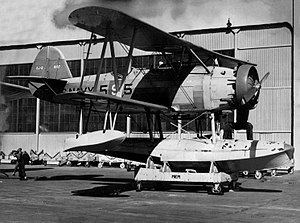Top speed 243 km/h Length 7.82 m Retired 1941 | Wingspan 11 m Introduced 1933 Manufacturer Berliner-Joyce | |
 | ||
The Berliner-Joyce OJ was a U.S. observation aircraft built by Berliner-Joyce Aircraft.
Contents
Development and design
The OJ was a two-seat twin-float biplane with a fabric covered fuselage and staggered wings. The prototype designated XOJ-1 first flew in May 1931. It was designed to meet a United States Navy requirement, Bureau of Aeronautics (BuAer) Design No. 86, for a lightweight observation biplane that could be used from catapults on light cruisers. The other design built to this same plan was the Keystone XOK-1, the sole prototype serialled A-8357. It first flew on 5 January 1931, but was destroyed in a crash 15 April 1931, during a demonstration before naval officials when a piece of its NACA-style engine cowling detached itself, smashed into the wings and tailplane, causing the airframe to break up in flight. Although the test piloted successfully bailed out, with the Berliner-Joyce XOJ-1 and Vought XO4U-1 (built to a slightly different specification) nearly ready for trials, BuAer decided to discontinue XOK-1 development.
After winning the competition against Keystone, an order for 18 aircraft production aircraft designated OJ-2 was placed with Berliner-Joyce by the Navy in March 1932. Two follow on orders were placed, one in May 1933 for nine aircraft and a further 12 aircraft in December 1933 for use by reserve units. A request for a modified version designated XOJ-3 which was to have a partially closed canopy and other improvements was abandoned.
Operational history
The OJ entered service with VS-5B and VS-6B in 1933 mainly for use on Omaha class light cruisers. Some OJs were used by reserve units with the first being VN-6R which were based near Washington to train reserve pilots and to enable staff officers to maintain their flying categories. By 1936 all the remaining aircraft were operated by reserve units and at the outbreak of the Second World War 29 aircraft were still in service. The Navy stopped the overhaul program for the aircraft and by the middle of 1941 all of them had been struck off charge.
Unusually for its generation, only four aircraft were lost in accidents without any loss of life.
Variants
Operators
Specifications
Data from
General characteristics
Performance
Armament
